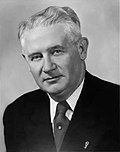| |||||||||||||||||
| |||||||||||||||||
 County results Hunt: 50–60% 60–70% 70–80% Robertson: 50–60% 60–70% | |||||||||||||||||
| |||||||||||||||||
| Elections in Wyoming |
|---|
 |
The 1948 United States Senate election in Wyoming was held on November 2, 1948. First-term Republican Senator Edward V. Robertson ran for re-election to a second term. He was challenged in the general election by Democrat Lester C. Hunt, the Governor of Wyoming. Aided in part by President Harry S. Truman's narrow victory in Wyoming over Republican Thomas E. Dewey, and with his own record of winning statewide in Wyoming, Hunt defeated Robertson in a landslide. However, Hunt would not serve a full term in the Senate; he died by suicide on June 19, 1954, and Republican Edward D. Crippa was appointed to replace him. As of 2023, this was the last time an incumbent Senator from Wyoming lost re-election for this seat.

